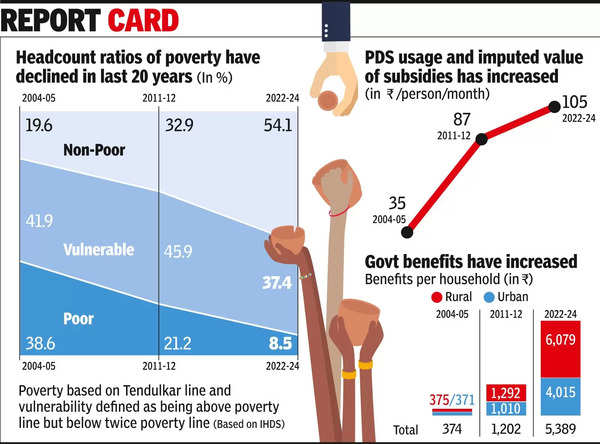- News
- Business News
- India Business News
- Poverty dips to 8.5% from 21% in 2011-12, says NCAER paper
Trending
Poverty dips to 8.5% from 21% in 2011-12, says NCAER paper

NEW DELHI: A new survey has estimated poverty to have declined to 8.5% from 21% in 2011-12 and pointed out that chronic poverty has come down but there is a significant proportion of people who can slip back into poverty due to “accident of life”.
Based on the initial findings of the just-concluded India Human Development Survey, it has estimated headcount ratios of poverty using inflation-adjusted poverty line by the Tendulkar Committee, which is used by govt to formulate and implement its schemes.This is lower than the World Bank’s $2.15 international poverty line using the 2017 purchasing power parity.
A paper by economists led by Sonalde Desai of think tank NCAER, which was released on Tuesday, estimated a sharper fall in headcount poverty ratios in rural areas — from 24.8% in 2011-12 to 8.6% now. In urban areas it decreased from 13.4% to 8.4%.
 The estimates are higher than SBI Research, which used the NSSO’s Household Consumption Expenditure Survey to estimate rural poverty at 7.2% and urban at 4.6%. In March, former RBI governor C Rangarajan and economist S Mahendra Dev have estimated India’s poverty rate to have declined to 10.8% in 2022-23, compared to 2011-12, based on HCES. Niti Aayog CEO B V R Subhramanyam had recently indicated that the poverty level could be less than 5% based on preliminary estimates on the household consumption expenditure data released by the statistics office.
The estimates are higher than SBI Research, which used the NSSO’s Household Consumption Expenditure Survey to estimate rural poverty at 7.2% and urban at 4.6%. In March, former RBI governor C Rangarajan and economist S Mahendra Dev have estimated India’s poverty rate to have declined to 10.8% in 2022-23, compared to 2011-12, based on HCES. Niti Aayog CEO B V R Subhramanyam had recently indicated that the poverty level could be less than 5% based on preliminary estimates on the household consumption expenditure data released by the statistics office.
It, however, suggested that the approach to social protection must pay greater attention to circumstances of life, such as illness, marriage and natural disasters, which push people into poverty rather than circumstances of birth associated with social identity or region of birth.
Using IHDS data for 2011-12 and 2022-24, the paper estimated that out of 8.5% poor, 3.2% were poor by birth, while 5.3% became poor due to “accident of life”.
“Historically, India’s approach to social safety nets has involved identifying the poor and providing them with priority access to various social protection programmes that include both in-kind and cash assistance—however, the nature of poverty changes with economic growth,” says the paper presented at India Policy Forum on Tuesday, adding that identifying the poor is often a challenge.
The paper said economic growth and poverty decline create a dynamic climate that requires nimble social protection programmes. “Ensuring that social protection systems keep up with the pace of social transformation will be a key challenge facing India as it strives towards equitable development,” it said.
It said that flexibility remains key to ensuring effective programme design that can respond to changing conditions. Rights-based approaches that institute pro grams through legislative acts sometimes create such inflexible systems that they fail the purposes for which they were designed and cites the example of MGNREGS.
The paper has suggested three principles for thinking about safety which include universal programs for a limited set of basic safety nets, risk insurance and building in flexibility and institutional framework.
It proposed that identifying and keeping the core set limited and fully funded is the challenge. “Massive expansion of the number of programs without concomitant resource increase would render this approach futile,” the paper said while detailing the reasons for making universal programs for a limited set of basic safety nets.
Based on the initial findings of the just-concluded India Human Development Survey, it has estimated headcount ratios of poverty using inflation-adjusted poverty line by the Tendulkar Committee, which is used by govt to formulate and implement its schemes.This is lower than the World Bank’s $2.15 international poverty line using the 2017 purchasing power parity.
A paper by economists led by Sonalde Desai of think tank NCAER, which was released on Tuesday, estimated a sharper fall in headcount poverty ratios in rural areas — from 24.8% in 2011-12 to 8.6% now. In urban areas it decreased from 13.4% to 8.4%.

Desai’s paper estimated that there was a significant in crease in food subsidy through the public distribution system and other benefits through multiple schemes run by the Centre as well as the states.
It, however, suggested that the approach to social protection must pay greater attention to circumstances of life, such as illness, marriage and natural disasters, which push people into poverty rather than circumstances of birth associated with social identity or region of birth.
Using IHDS data for 2011-12 and 2022-24, the paper estimated that out of 8.5% poor, 3.2% were poor by birth, while 5.3% became poor due to “accident of life”.
“Historically, India’s approach to social safety nets has involved identifying the poor and providing them with priority access to various social protection programmes that include both in-kind and cash assistance—however, the nature of poverty changes with economic growth,” says the paper presented at India Policy Forum on Tuesday, adding that identifying the poor is often a challenge.
The paper said economic growth and poverty decline create a dynamic climate that requires nimble social protection programmes. “Ensuring that social protection systems keep up with the pace of social transformation will be a key challenge facing India as it strives towards equitable development,” it said.
It said that flexibility remains key to ensuring effective programme design that can respond to changing conditions. Rights-based approaches that institute pro grams through legislative acts sometimes create such inflexible systems that they fail the purposes for which they were designed and cites the example of MGNREGS.
The paper has suggested three principles for thinking about safety which include universal programs for a limited set of basic safety nets, risk insurance and building in flexibility and institutional framework.
It proposed that identifying and keeping the core set limited and fully funded is the challenge. “Massive expansion of the number of programs without concomitant resource increase would render this approach futile,” the paper said while detailing the reasons for making universal programs for a limited set of basic safety nets.
End of Article
FOLLOW US ON SOCIAL MEDIA















